Australia So Much to See


Broken Hill, New South Wales - history, mining and art

Operations began at the RFDS Broken Hill Base in May 1936. It was here at Broken Hill, during the Queen's 1954 visit that the Flying
Doctor Service received the “Royal" prefix.
From Broken Hill Base, RFDS provides emergency flights covering a land mass of approximately
640,000 square kilometres. RFDS also operates a network of primary health clinics where patients can access community health nurses,
dentists, mental health and allied health professionals.
The Nomad is a fixed wing, twin engine turbo prop, short take-off and
landing aircraft. 170 Nomads were built at Fishermen's Bend, Melbourne, between 1978 and 1985.
The Nomad aircraft
has proved successful on short, rough landing strips of outback Australia, and became internationally famous in the television series
"The Flying Doctors".
Broken Hill is divided by the Line of Load, with the suburb of South Broken Hill being south of this line. The airport is in
South Broken Hill. Adjoining the airport is the Royal Flying Doctor Base.
Nomad N22C on display at the RFDS Base, Broken Hill. This aircraft was purchased as a shell by the Broken Hill City Council for external restoration and display purposes.
Opened in 2015, the AGL Broken Hill solar plant produces enough electricity to power 22,000 homes from 678,000 solar modules over
the 140 hectare site. This site, on the western side of Broken Hill, situated between the Barrier Highway and the East-West
(Indian-Pacific) railway line.
This solar plant when completed will reduce greenhouse gas emissions by over 105,840
tonnes of CO² equivalent per annum. Particulate and heavy metal emissions will also be reduced.
Sources:
How Broken Hill became a solar power trailblazer
Details of the Broken Hill solar power plant
See also the largest solar power plant in the southern hemisphere with 1,350,000 solar modules covering 250 hectares at Nyngan, New South Wales which produces enough electricity to power 40,000 houses.
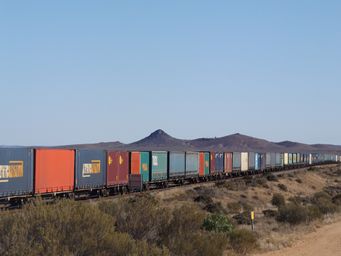
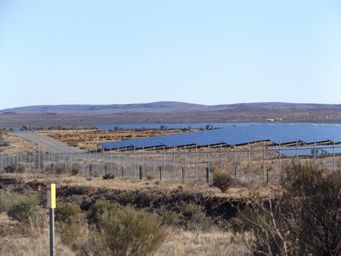
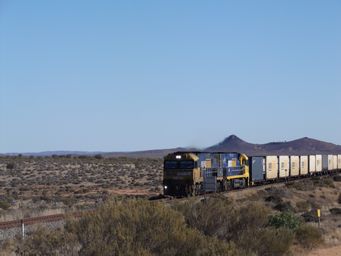
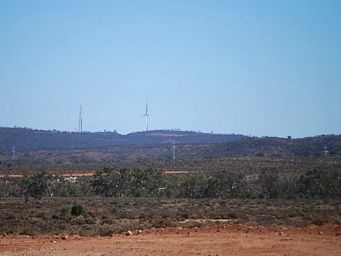
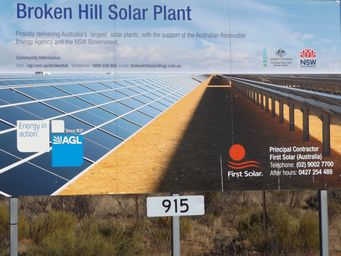
Currently being constructed at a cost of $450 million, the wind powered turbines at Silverton will add to the clean energy
produced in the Broken Hill region. When completed, this power plant will produce enough energy to power 135,000 average Australian
homes.
To the west of Broken Hill is a landmark row of hills known as The Pinnacles. These can be seen when approaching Broken Hill
from the west, south and north. Viewing these hills from near the Solar Power Plant, a passing freight train had a colourful
array of wagons.
On a hill known as Sundown Hill (site of the Sundown Trig Point), eleven
kilometres north of Broken Hill, a symposium of sculptors from around the world gathered to create the sculptural collection proposed
and organised by sculptor Lawrence Beck.
The artists of the symposium camped at the site. Major sponsor Was the Broken
Hill City Council, with support from Australia Council and the people of Broken Hill. Fifty three tonne of Wilcannia stone was
moved to the site by volunteers. The area was being developed as a reserve, and the sculptures on the hill became the centre
piece of the Living Desert Reserve.
While the sculptures are known internationally, there is much more to the Living Desert. This 2,400 hectare reserve encompasses a 180 hectare flora and fauna sanctuary and cultural sites. There are flora, fauna and cultural walk trails.
Entry to the reserve is $6 per person, or an annual pass can be purchased. See the opening of Starview Campsite which is can been seen in the photo above right.
A cultural heritage enclosure protects the remains of at least seven ground ovens. Windoo, or ground ovens, were made by scooping
out a hollow in the ground and lining it with hot stones, then placing branches over the stones. Large animals or vegetables
requiring longer cooking were placed on the branches, then covered with more branches and enclosing with soil. Moisture was
added if needed.
The flora and fauna sanctuary is kept predator proof by mesh and electric fencing. You can take a walk within the enclosure,
where kangaroos and wallabies are looked after. Walks are shown on the sign below left, and on this brochure
This is in an area also known as Sundown not far to the east of Sundown Hill where the Sculptures are features in the Living Desert,
but it is accessed from the Silver City Highway. There is a 2.8 kilometre return walk to the hills. See Sundown Nature
Trail.
Sundown Nature Walk